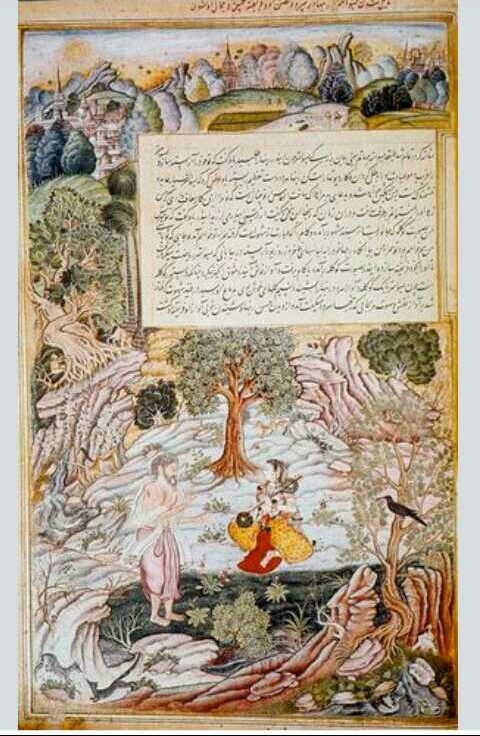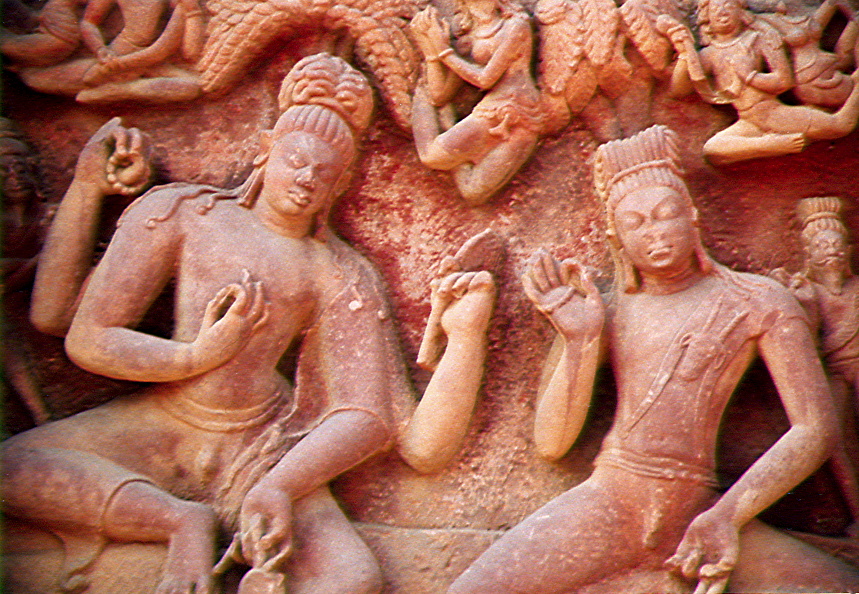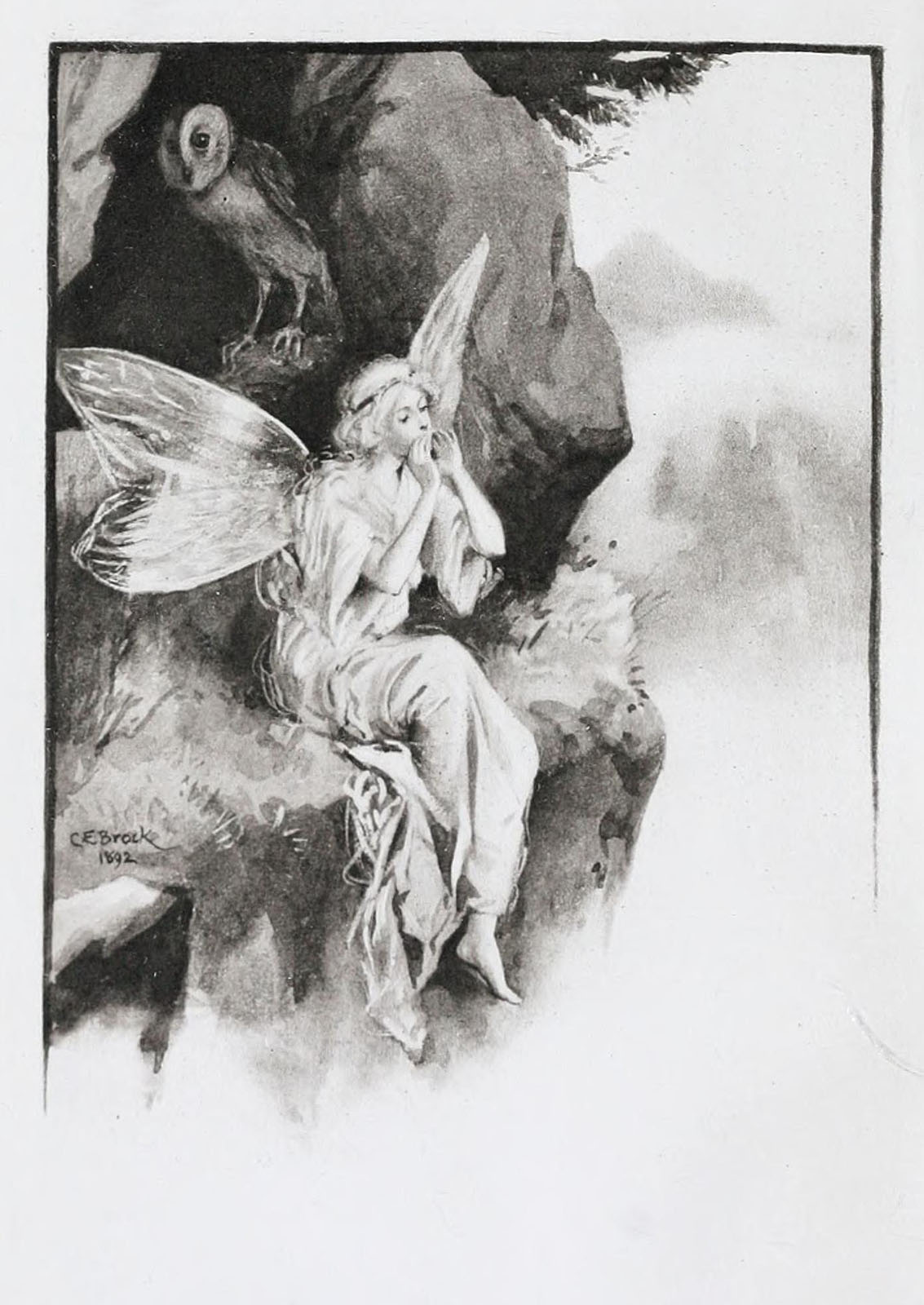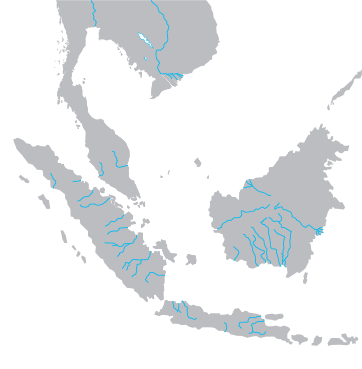|
Apsaras
Apsaras (, , Khmer: អប្សរា are a class of celestial beings in Hindu and Buddhist culture. They were originally a type of female spirit of the clouds and waters, but, later play the role of a "nymph" or "fairy". They figure prominently in the sculptures, dance, literature and paintings of many South Asian and Southeast Asian cultures. The apsaras are described to be beautiful, youthful and elegant, and are said to be able to change their shape at will; making anyone fall for their beauty. There are two types of apsaras—''laukika'' (worldly) and ''daivika'' (divine). They are great in the art of dancing, and often wives of the gandharvas, the court musicians of Indra. The apsaras reside in the palaces of the gods and entertain them by dancing to the music made by the Gandharvas. The 26 apsaras of Indra's court are each said to symbolise a different facet of the performing arts, drawing comparisons to the Muses of ancient Greece. They are also renowned for ... [...More Info...] [...Related Items...] OR: [Wikipedia] [Google] [Baidu] [Amazon] |
Rambha (apsara)
Rambha () is one of the prominent apsaras, the celestial nymphs of Svarga (a heaven), in Hindu mythology. She is extolled to be unrivalled in her accomplishments in the arts of dancing, music, and beauty. Legends Birth According to the ''Adi Parva'' of the epic ''Mahabharata'', Rambha and her apsaras sisters Alambusha, Mishrakeshi, Vidhyutparna, Tilottama, Aruna, Rakshita, Manorama, Subahu, Keshini, Surata and Suraja are the daughters of the sage Kashyapa and his wife Pradha. In the ''Bhagavata Purana'', the name of the mother of the Apsaras is Muni. In some ''Puranic'' scriptures, a varying account is found, according to which Rambha and other apsaras emerged from Kshira Sagara (the ocean of milk) during Samudra Manthana (the churning of the ocean). Encounter with Vishvamitra Rambha and other apsaras are frequently sent by the king of the devas, Indra, to seduce rishis (sages) and ensuring that they don't gain divine powers by self-abnegation and austerities. The ''Bala ... [...More Info...] [...Related Items...] OR: [Wikipedia] [Google] [Baidu] [Amazon] |
Urvashi
Urvashi (, ) is the most prominent apsara mentioned in the Hindu scriptures like the ''Vedas'', the epics ''Ramayana'' and ''Mahabharata'', as well as the ''Puranas''. She is regarded as the most beautiful of all the apsaras, and an expert dancer. Urvashi has been featured in many mythological events. She emerged out of the thigh of sage Narayana and occupies a special place in the court of Indra, the king of the gods and ruler of svarga. She is famous for her marriage with Pururavas, the first king of the legendary ''Chandravamsha'', whom she later abandoned. She also plays a significant part in the birth of Vashishtha and Agastya, two of the most revered sages in Hinduism. Urvashi's story has been an inspiration for various arts, performances and literature. The poet Kalidasa (fl. 4th -5th century CE) has adapted Urvashi and Pururavas as the main characters in his play Vikramorvashiyam. Etymology The Sanskrit name ''"Urvaśī"'' is derived from roots''uru'' and ''aś''. ... [...More Info...] [...Related Items...] OR: [Wikipedia] [Google] [Baidu] [Amazon] |
Nymph
A nymph (; ; sometimes spelled nymphe) is a minor female nature deity in ancient Greek folklore. Distinct from other Greek goddesses, nymphs are generally regarded as personifications of nature; they are typically tied to a specific place, landform, or tree, and are usually depicted as Virginity, maidens. Because of their association with springs, they were often seen as having healing properties; other divine powers of the nymphs included divination and shapeshifting. In spite of their divine nature, they were not immortality, immortal. Nymphs are divided into various Nymph#List, broad subgroups based on their habitat, such as the Meliae (ash tree nymphs), the Dryads (oak tree nymphs), the Alseids (Grove (nature), grove nymphs), the Naiads (Spring (hydrology), spring nymphs), the Nereids (sea nymphs), the Oceanids (ocean nymphs), and the Oreads (mountain nymphs). Other nymphs included the Hesperides (evening nymphs), the Hyades (mythology), Hyades (rain nymphs), and the Pleiade ... [...More Info...] [...Related Items...] OR: [Wikipedia] [Google] [Baidu] [Amazon] |
Fairy
A fairy (also called fay, fae, fae folk, fey, fair folk, or faerie) is a type of mythical being or legendary creature, generally described as anthropomorphism, anthropomorphic, found in the folklore of multiple European cultures (including Celtic mythology, Celtic, Slavic paganism, Slavic, Germanic folklore, Germanic, and French folklore, French folklore), a form of Supernatural#Spirit, spirit, often with metaphysical, supernatural, or preternatural qualities. Myths and stories about fairies do not have a single origin but are rather a collection of folk beliefs from disparate sources. Various folk theories about the origins of fairies include casting them as either demoted angels or demons in a Christian mythology, Christian tradition, as deities in Paganism, Pagan belief systems, as Spirit (supernatural entity), spirits of the dead, as Prehistory, prehistoric precursors to humans, or as spirits of nature. The label of ''fairy'' has at times applied only to specific Magic (su ... [...More Info...] [...Related Items...] OR: [Wikipedia] [Google] [Baidu] [Amazon] |
Ghritachi
Ghritachi () is a prominent apsara (celestial nymph) in Hindu mythology. She is known for her beauty and seduction of many men, both divine and human, and for becoming the mother of their children. Literature Ghritachi appears in many Hindu religious scriptures, including the epics, the ''Ramayana'' and the ''Mahabharata'', as well as the ''Puranas''. She is described to be belonging to the ''daivika'' (lit. 'divine') class of apsaras, and presides over Kumbha, a month in Indian lunisolar calendar. The scriptures describe her procilivity to seduce men, including rishis (sages), gandharvas (celestial musicians), devas (gods) and kings. According to the ''Vamana Purana'', Ghritachi once lived with Vishvakarma, the architect of the gods, and had a daughter named Chitrangada. Vishvakarma prohibits his daughter to marry anyone, due to which he is cursed to become a vanara (monkey) till a son is borne to him; Ghritachi liberates him by giving birth to Nala, who later helps the god Ram ... [...More Info...] [...Related Items...] OR: [Wikipedia] [Google] [Baidu] [Amazon] |
Pāli
Pāli (, IAST: pāl̤i) is a classical Middle Indo-Aryan language of the Indian subcontinent. It is widely studied because it is the language of the Buddhist ''Pāli Canon'' or '' Tipiṭaka'' as well as the sacred language of '' Theravāda'' Buddhism. Pali was designated as a classical language by the Government of India on 3 October 2024. Origin and development Etymology The word 'Pali' is used as a name for the language of the Theravada canon. The word seems to have its origins in commentarial traditions, wherein the (in the sense of the line of original text quoted) was distinguished from the commentary or vernacular translation that followed it in the manuscript. K. R. Norman suggests that its emergence was based on a misunderstanding of the compound , with being interpreted as the name of a particular language. The name Pali does not appear in the canonical literature, and in commentary literature is sometimes substituted with , meaning a string or lineage. Thi ... [...More Info...] [...Related Items...] OR: [Wikipedia] [Google] [Baidu] [Amazon] |
Celestial Fairies Apsaras On Hindu Temple At Banares 1913
Celestial may refer to: Science * Objects or events seen in the sky and the following astronomical terms: ** Astronomical object, a naturally occurring physical entity, association, or structure that exists in the observable universe ** Celestia, a 3D astronomy program that allows users to travel through the universe, also known as a celestial body or object ** Celestial coordinate system, a system for mapping positions on the celestial sphere ** Celestial mechanics, the branch of astronomy that deals with the motions of celestial objects ** Celestial navigation, a position-fixing technique that helps sailors cross the oceans ** Celestial pole, the two points in the sky, north and south, where the projection of a planet's axis of rotation intersects its celestial sphere ** Celestial sphere, an imaginary sphere concentric with the Earthall objects in the sky can be thought of as projected upon the celestial sphere ** Celestial spheres, fundamental entities of the cosmological mo ... [...More Info...] [...Related Items...] OR: [Wikipedia] [Google] [Baidu] [Amazon] |
Sanskrit
Sanskrit (; stem form ; nominal singular , ,) is a classical language belonging to the Indo-Aryan languages, Indo-Aryan branch of the Indo-European languages. It arose in northwest South Asia after its predecessor languages had Trans-cultural diffusion, diffused there from the northwest in the late Bronze Age#South Asia, Bronze Age. Sanskrit is the sacred language of Hinduism, the language of classical Hindu philosophy, and of historical texts of Buddhism and Jainism. It was a lingua franca, link language in ancient and medieval South Asia, and upon transmission of Hindu and Buddhist culture to Southeast Asia, East Asia and Central Asia in the early medieval era, it became a language of religion and high culture, and of the political elites in some of these regions. As a result, Sanskrit had a lasting effect on the languages of South Asia, Southeast Asia and East Asia, especially in their formal and learned vocabularies. Sanskrit generally connotes several Indo-Aryan languages# ... [...More Info...] [...Related Items...] OR: [Wikipedia] [Google] [Baidu] [Amazon] |
Monier Monier-Williams
Sir Monier Monier-Williams (; né Williams; 12 November 1819 – 11 April 1899) was a British scholar who was the second Boden Professor of Sanskrit at Oxford University, England. He studied, documented and taught Asian languages, especially Sanskrit, Persian and Hindustani. Early life and education Monier Williams was born in Bombay, the son of Colonel Monier Williams, surveyor-general in the Bombay presidency. His surname was "Williams" until 1887, when he added his given name to his surname to create the hyphenated "Monier-Williams". In 1822, he was sent to England to be educated at private schools at Hove, Chelsea and Finchley. He was educated at King's College School, Balliol College, Oxford (1838–40), the East India Company College (1840–41) and University College, Oxford (1841–44). He took a fourth-class honours degree in Literae Humaniores in 1844. He married Julia Grantham, daughter of Rev. Francis Joseph Faithfull, in 1848. They had six sons and one ... [...More Info...] [...Related Items...] OR: [Wikipedia] [Google] [Baidu] [Amazon] |
Tausūg Language
Tausūg (, , , ) is an Austronesian language spoken in the province of Sulu in the Philippines and in the eastern area of the state of Sabah, Malaysia. It is widely spoken in the Sulu Archipelago (Sulu, Tawi-Tawi, and Basilan), the Zamboanga Peninsula (Zamboanga del Norte, Zamboanga Sibugay, Zamboanga del Sur, and Zamboanga City), southern Palawan, Malaysia (eastern Sabah), and Indonesia ( Tarakan City and Nunukan Regency, province of North Kalimantan). Tausūg has some lexical similarities or near similarities with Surigaonon language of the provinces Surigao del Norte, Surigao del Sur, and Agusan del Sur and with the Butuanon language of Agusan del Norte; it has also some vocabulary similarities with Sugbuanon, Bicolano, and with other Philippine languages. Many Malay and Arabic words are found in Tausug language. Nomenclature In English, the language is primarily known as Tausug (i.e., Tausug language). The local name of the language is ''bahasa Sūg'' or ''Sinūg' ... [...More Info...] [...Related Items...] OR: [Wikipedia] [Google] [Baidu] [Amazon] |
Malay Language
Malay ( , ; , Jawi alphabet, Jawi: ) is an Austronesian languages, Austronesian language spoken primarily by Malays (ethnic group), Malays in several islands of Maritime Southeast Asia and the Malay Peninsula on the mainland Asia. The language is an official language of Brunei, Malaysia, and Singapore. Indonesian language, Indonesian, a standardized variety of Malay, is the official language of Indonesia and one of the working languages of East Timor. Malay is also spoken as a regional language of Malays (ethnic group), ethnic Malays in Indonesia and the Thai Malays, southern part of Thailand. Altogether, it is spoken by 60 million people across Maritime Southeast Asia. The language is pluricentric and a ISO 639 macrolanguage, macrolanguage, i.e., a group of Mutual intelligibility, mutually intelligible speech varieties, or dialect continuum, that have no traditional name in common, and which may be considered distinct languages by their speakers. Several varieties of it ar ... [...More Info...] [...Related Items...] OR: [Wikipedia] [Google] [Baidu] [Amazon] |
Maranao Language
Maranao (; Jawi Script, Jawi: ), sometimes spelled as Maranaw, Meranaw or Mëranaw, is an Austronesian languages, Austronesian language spoken by the Maranao people in the provinces of Lanao del Sur and Lanao del Norte and their respective cities of Marawi and Iligan City, Iligan located in the Philippines, as well found also in Sabah, Malaysia. It is spoken among the Moro people, Moros within the Bangsamoro Autonomous Region in Muslim Mindanao. It is more closer to Iranun language, Iranun than to Maguindanao language, Maguindanao within the Danao languages, Danao subgroup. Distribution : Maranao is spoken in the following provinces of: • Entire Lanao del Sur and Lanao del Norte • Northwestern municipalities of Maguindanao del Norte: Barira, Buldon, Parang, Maguindanao del Norte, Parang, Matanog, Sultan Mastura, and Sultan Kudarat, Maguindanao del Norte, Sultan Kudarat • Northwestern municipalities of Cotabato: Alamada, Banisilan, Carmen, Cotabato, Carmen, Lib ... [...More Info...] [...Related Items...] OR: [Wikipedia] [Google] [Baidu] [Amazon] |








